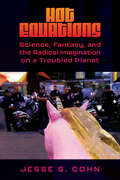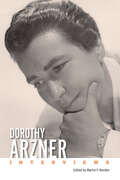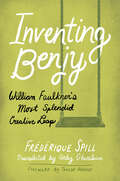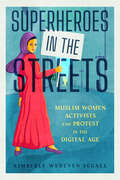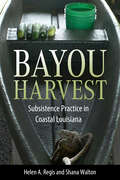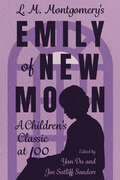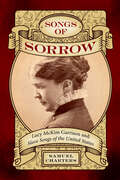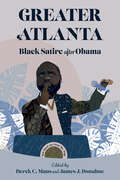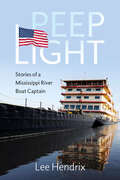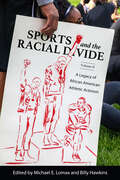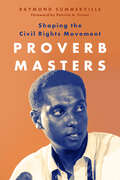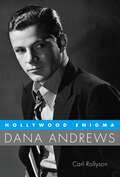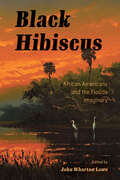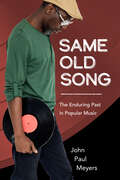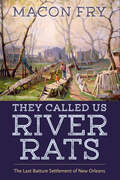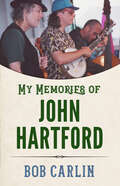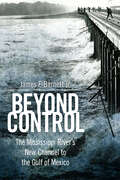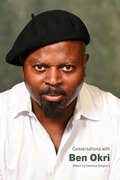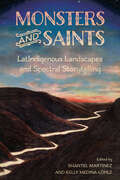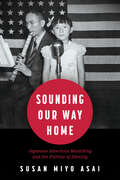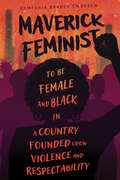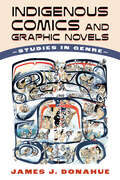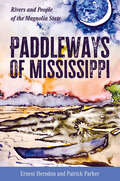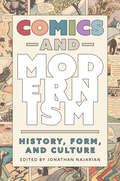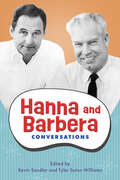- Table View
- List View
Hot Equations: Science, Fantasy, and the Radical Imagination on a Troubled Planet
by Jesse S. CohnInspired by the new diversity of science fiction, fantasy, and horror in the twenty-first century, Hot Equations: Science, Fantasy, and the Radical Imagination on a Troubled Planet confronts the kinds of literary and political “realism” that continue to suppress the radical imagination. Alluding both to the ongoing climate catastrophe and to Tom Godwin’s “The Cold Equations”—that famous touchstone of “hard science fiction”—Hot Equations reads the crises of our "post-normal" moment via works that increasingly subvert genre containment and spill out into the public sphere. Drawing on archives and contemporary theory, author Jesse S. Cohn argues that these imaginative works of science fiction, fantasy, and horror strike at the very foundations of modernity, calling its basic assumptions into question. They threaten the modern order with a simultaneously terrible and promising anarchy, pointing to ways beyond the present medical, ecological, and political crises of pandemic, climate change, and rising global fascism. Examining books ranging from well-known titles like The Hunger Games and The Caves of Steel to newer works such as Under the Pendulum Sun and The Stone Sky, Cohn investigates the ways in which science fiction, fantasy, and horror address contemporary politics, social issues, and more. The “cold equations” that established normal life in the modern world may be in shambles, Cohn suggests, but a New Black Fantastic makes it possible for the radical imagination to glimpse viable possibilities on the other side of crisis.
Dorothy Arzner: Interviews (Conversations with Filmmakers Series)
by Martin F. NordenThrough dozens of interviews, a detailed chronology and filmography, and a selection of Dorothy Arzner’s own writings—including her unfinished autobiography—Dorothy Arzner: Interviews offers major insights into and an in-depth examination of the life and career of one of the few women to direct films during Hollywood’s Golden Age. A key figure in Hollywood for decades, she directed more studio films than any other woman in history. Her movies often focused on courageous women who must make difficult decisions to remain true to themselves—women not unlike Arzner herself, who once said that “all we can ever do in our work is write our own biography.”Dorothy Arzner (1897–1979) began her film career in 1919 as a script typist for the Famous Players-Lasky company, which later became Paramount Pictures. She quickly rose through the ranks to become a script supervisor, screenwriter, and editor before directing her first film, Fashions for Women, in 1927. After the release of her final Hollywood film, First Comes Courage, in 1943, Arzner changed directions in her professional life. She made several training films for the Women’s Army Auxiliary Corps during World War II and directed many television commercials for Pepsi-Cola in the 1950s. She concluded her career by serving as a filmmaking instructor at the Pasadena Playhouse College of Theatre Arts and UCLA, where she helped launch the first wave of college-trained moviemakers.
Inventing Benjy: William Faulkner’s Most Splendid Creative Leap
by Frédérique SpillInventing Benjy: William Faulkner’s Most Splendid Creative Leap is a groundbreaking work at the intersection of Faulkner studies and disability studies. Originally published in 2009 by Presses de la Sorbonne Nouvelle as L’Idiotie dans l’œuvre de Faulkner, this translation brings the book to English-language readers for the first time. Author Frédérique Spill begins with a sustained look at the monologue of Benjy Compson, the initial first-person narrator in Faulkner’s The Sound and the Fury. Spill questions the reasons for this narrative choice, bringing readers to consider Benjy’s monologue, which is told by a narrator who is deaf and cognitively disabled, as an impossible discourse. This paradoxical discourse, which relies mostly on senses and sensory perception, sets the foundation of a sophisticated poetics of idiocy. Using this form of writing, Faulkner shaped perspective from a disabled character, revealing a certain depth to characters that were previously only portrayed on a shallow level. This style encompasses some of the most striking forms and figures of his leap into modern(ist) writing. In that respect, Inventing Benjy thoroughly examines Benjy’s discourse as an experimental workshop in which objects and words are exclusively modelled by the senses. This study regards Faulkner’s decision to place a disabled character at the center of perception as the inaugural and emblematic gesture of his writing. Closely examining excerpts from Faulkner’s novels and a few short stories, Spill emphasizes how the corporal, temporal, sensorial, and narrative figures of "idiocy" are reflected throughout Faulkner’s work. These writing choices underlie some of his most compelling inventions and certainly contribute to his unmistakable writing style. In the process, Faulkner’s writing takes on a phenomenological dimension, simultaneously dismantling and reinventing the intertwined dynamics of perception and language.
Superheroes in the Streets: Muslim Women Activists and Protest in the Digital Age (Race, Rhetoric, and Media Series)
by Kimberly Wedeven SegallThe icon of the female protester and her alter-ego, the female superhero, fills screens in the news, in theaters, and in digital spaces. The female protester who is Muslim, though, has been subject to a legacy of discrimination. Superheroes in the Streets: Muslim Women Activists and Protest in the Digital Age follows the stories of both famous and grassroots Muslim female protestors, bringing careful attention to protest modes and online national icons.US Muslim women have long navigated public and digital spaces aware of the complex and nuanced histories that trail them. Given the pervasive influence of mainstream feminism, Muslim women activists are often made out to be damsels in distress. Even when mass media turns its attention to the activism of Muslim women, persistence of these false narratives demeans their culture and hypersexualizes their bodies.Following the stories of US Muslim women activists, author Kimberly Wedeven Segall shows how they have been reinventing the streets and remaking racialized codifications. Segall highlights their creativity in crafting protest media of posters, rap rally songs, and digital images of superheroes, carving public spaces into inclusive and digital territories. Each chapter teases apart the complexities of public banners and digital activism.
Bayou Harvest: Subsistence Practice in Coastal Louisiana (America's Third Coast Series)
by Helen A. Regis Shana WaltonTo inhabitants of the Gulf Coast region of Louisiana, food is much more than nourishment. The acts of gathering, preparing, and sharing food are ways to raise children, bond with friends, and build community. In Bayou Harvest: Subsistence Practice in Coastal Louisiana, Helen A. Regis and Shana Walton examine how coastal residents deploy self-reliance and care for each other through harvesting and sharing food. Pulling from four years of fieldwork and study, Walton and Regis explore harvesting, hunting, and foraging by Native Americans, Cajuns, and other Bayou residents. This engagement with Indigenous thinkers and their neighbors yields a multifaceted view of subsistence in Louisiana. Readers will learn about coastal residents’ love for the land and water, their deep connections to place, and how they identify with their food and game heritage. The book also delves into their worries about the future, particularly storms, pollution, and land loss in the coastal region. Using a set of narratives that documents the everyday food practices of these communities, the authors conclude that subsistence is not so much a specific task like peeling shrimp or harvesting sassafras, but is fundamentally about what these activities mean to the people of the coast. Drawn together with immersive writing, this book explores a way of life that is vibrant, built on deep historical roots, and profoundly threatened by the Gulf’s shrinking coast.
L. M. Montgomery's Emily of New Moon: A Children's Classic at 100 (Children's Literature Association Series)
by Yan Du and Joe Sutliff SandersContributions by Yoshiko Akamatsu, Carol L. Beran, Rita Bode, Lesley D. Clement, Allison McBain Hudson, Kate Lawson, Jessica Wen Hui Lim, Lindsey McMaster, E. Holly Pike, Katharine Slater, Margaret Steffler, and Anastasia Ulanowicz Lucy Maud Montgomery (1874–1942) was a Canadian author best known for writing the wildly popular Anne of Green Gables. At the time of its publication in 1908, it was an immediate bestseller and launched Montgomery to fame. Less known than the dreamy and accidentally mischievous Anne Shirley is Emily Byrd Starr, the title character in the trilogy that followed much later in Montgomery’s professional career, Emily of New Moon. Published in 1923, Emily of New Moon is the first in a series of novels about an orphan girl growing up on Prince Edward Island, a story that mirrors Anne’s but intentionally resists many of the defining qualities of Montgomery's most famous creation. Despite being overshadowed by the immense popularity of Anne of Green Gables, the Emily of New Moon trilogy has become a subject of endless fascination to fans and scholars around the world. The trilogy was conceived during an important phase in Montgomery’s career during which she turned from Anne and plunged into more intricate aspects of gender, adolescence, nature, and authorship. While the novels have attracted rich critical attention since their publication, book-length studies proved surprisingly scarce. L. M. Montgomery’s "Emily of New Moon": A Children’s Classic at 100 is the first scholarly volume exclusively dedicated to the trilogy, coalescing different research perspectives. It offers a fresh point of entrance into a well-loved classic at its one-hundredth anniversary.
Songs of Sorrow: Lucy McKim Garrison and Slave Songs of the United States (American Made Music Series)
by Samuel ChartersIn the spring of 1862, Lucy McKim, the nineteen-year-old daughter of a Philadelphia abolitionist Quaker family, traveled with her father to the Sea Islands of South Carolina to aid him in his efforts to organize humanitarian aid for thousands of newly freed slaves. During her stay she heard the singing of the slaves in their churches, as they rowed their boats from island to island, and as they worked and played. Already a skilled musician, she determined to preserve as much of the music as she could, quickly writing down words and melodies, some of them only fleeting improvisations. Upon her return to Philadelphia, she began composing musical settings for the songs and in the fall of 1862 published the first serious musical arrangements of slave songs. She also wrote about the musical characteristics of slave songs, and published, in a leading musical journal of the time, the first article to discuss what she had witnessed. In Songs of Sorrow: Lucy McKim Garrison and “Slave Songs of the United States,” renowned music scholar Samuel Charters tells McKim's personal story. Letters reveal the story of young women's lives during the harsh years of the war. At the same time that her arrangements of the songs were being published, a man with whom she had an unofficial “attachment” was killed in battle, and the war forced her to temporarily abandon her work. In 1865 she married Wendell Phillips Garrison, son of abolitionist William Lloyd Garrison, and in the early months of their marriage she proposed that they turn to the collection of slave songs that had long been her dream. She and her husband—a founder and literary editor of the recently launched journal The Nation—enlisted the help of two associates who had also collected songs in the Sea Islands. Their book, Slave Songs of the United States, appeared in 1867. After a long illness, ultimately ending in paralysis, she died at the age of thirty-four in 1877. This book reclaims the story of a pioneer in ethnomusicology, one whose influential work affected the Fisk Jubilee Singers and many others.
Greater Atlanta: Black Satire after Obama
by Derek C. Maus and James J. DonahueContributions by GerShun Avilez, Lola Boorman, Thomas Britt, John Brooks, Phillip James Martinez Cortes, Derek DiMatteo, Tikenya Foster-Singletary, Alexandra Glavanakova, Erica-Brittany Horhn, Matthias Klestil, Abigail Jinju Lee, Derek C. Maus, Danielle Fuentes Morgan, Derek Conrad Murray, Kinohi Nishikawa, Sarah O'Brien, Keyana Parks, and Emily Ruth RutterThe seventeen essays in Greater Atlanta: Black Satire after Obama collectively argue that in the years after the widespread hopefulness surrounding Barack Obama’s election as president waned, Black satire began to reveal a profound shift in US culture. Using the four seasons of the FX television show Atlanta (2016–22) as a springboard, the collection examines more than a dozen novels, films, and television shows that together reveal the ways in which Black satire has developed in response to contemporary cultural dynamics. Contributors reveal increased scorn toward self-proclaimed allies in the existential struggle still facing African Americans today.Having started its production within a few weeks of Donald Trump’s (in)famous escalator ride in 2015, Atlanta in many ways is the perfect commentary on the absurdities of the contemporary cultural moment. The series exemplifies a significant development in contemporary Black satire, which largely eschews expectations of reform and instead offers an exasperated self-affirmation that echoes the declaration that Black Lives Matter.Given anti-Black racism’s lengthy history, overt stimuli for outrage have predictably commanded African American satirists’ attention through the years. However, more recent works emphasize the willful ignorance underlying that history. As the volume shows, this has led to the exposure of performative allyship, virtue signaling, slacktivism, and other duplicitous forms of purported support as empty, oblivious gestures that ultimately harm African Americans as grievously as unconcealed bigotry.
Peep Light: Stories of a Mississippi River Boat Captain
by Lee HendrixMost people only consider the Mississippi River when they cross it or when it inconveniently abandons its banks. But every year, millions of tons of cargo are transported by towboats on the river. In Peep Light: Stories of a Mississippi River Boat Captain, Captain Lee Hendrix provides unique insight on people who work and live on and near the Mississippi River. Hendrix, formerly a pilot for the Delta Queen Steamboat Co., has worked on the Mississippi for fifty years, first as a towboat deckhand in 1972 and eventually as a pilot of towboats and passenger vessels. In 2014, Hendrix became captain of the towboat Mississippi with the US Army Corps of Engineers, then he later retired to return to passenger vessels. For Hendrix and others like him, he is at home on the river, living and dining with the same people they work with, working with familiar faces for years at a time and yet meeting new people every day.Demonstrating a fascination not only with the river but also with the passions and dreams of those who live and work on it, these stories range from personal reflections on aging, experiencing one’s first night on the river and the complex emotions that come with it, working on the deck, promotion to pilot, the characters working aboard these boats, and the history of the river itself. Peep Light unites humans with the river through engaging storytelling and sheds light on Hendrix’s rare experience along one of the most powerful and important waterways in the world.
Sports and the Racial Divide, Volume II: A Legacy of African American Athletic Activism
by Michael E. Lomax and Billy HawkinsContributions by Amy Bass, Ashley Farmer, Sarah K. Fields, Billy Hawkins, Kurt Edward Kemper, Michael E. Lomax, and David K. Wiggins In Sports and the Racial Divide, Volume II: A Legacy of African American Athletic Activism, Michael E. Lomax and Billy Hawkins draw together essays that examine evolving attitudes about race, sports, and athletic activism in the US. A follow-up to Lomax’s Sports and the Racial Divide: African American and Latino Experience in an Era of Change, this second anthology links post–World War II African American protest movements to a range of contemporary social justice interventions. Athlete activists have joined the ongoing pursuit for Black liberation and self-determination in a number of ways. Contributors examine some of these efforts, including the fight for HBCUs to enter the NCAA basketball tournament; Harry Edwards and the boycott of the 1968 Olympic Games; and US sporting culture in the post-9/11 era. Essays also detail topics like the protest efforts of San Francisco 49ers quarterback Colin Kaepernick; the link between the Black Power movement and the current Black Lives Matter movement; and the activism of athletes like Lebron James and Naomi Osaka. Collectively, these essays reveal a historical narrative in which African Americans have transformed the currency of athletic achievement into impactful political capital.
Proverb Masters: Shaping the Civil Rights Movement
by Raymond SummervilleIn Proverb Masters: Shaping the Civil Rights Movement, author Raymond Summerville explores how proverbs and proverbial language played a significant role in the long civil rights era. Proverbs have been used throughout history to share and disseminate brief, powerful statements of truth and philosophical insight. Oftentimes, these sayings have helped unite people in struggles for social justice, serving as rallying cries for just causes. During the civil rights era, proverbs allowed leaders to craft powerful and evocative messages. These statements needed to be made implicitly, as explicit messages were often met with retaliation and even violence.Looking at the autobiographies, biographies, speeches, diaries, letters, and critical texts of Charles W. Chesnutt, Ida B. Wells, A. Philip Randolph, Bob Dylan, Malcom X, Stokely Carmichael, and Septima Clark, the volume analyzes how these figures employed proverbs in support of social justice causes and in civil rights struggles. Summerville argues that these individuals generated enough print material embedded with proverbs and proverbial language that they should be considered proverb masters. With chapters dedicated to each figure, Summerville reveals their adept uses of this powerful linguistic tool.
Hollywood Enigma: Dana Andrews (Hollywood Legends Series)
by Carl RollysonDana Andrews (1909–1992) worked with distinguished directors such as John Ford, Lewis Milestone, Otto Preminger, Fritz Lang, William Wyler, William A. Wellman, Mervyn Le Roy, Jean Renoir, and Elia Kazan. He played romantic leads alongside the great beauties of the modern screen, including Joan Crawford, Elizabeth Taylor, Greer Garson, Merle Oberon, Linda Darnell, Susan Hayward, Maureen O'Hara, and most important of all, Gene Tierney, with whom he did five films. Retrospectives of his work often elicit high praise for an underrated actor, a master of the minimalist style. His image personified the “male mask” of the 1940s in classic films such as Laura, Fallen Angel, and Where the Sidewalk Ends, in which he played the “masculine ideal of steely impassivity.” No comprehensive discussion of film noir can neglect his performances. He was an “actor's actor.”Here at last is the complete story of a great actor, his difficult struggle to overcome alcoholism while enjoying the accolades of his contemporaries, a successful term as president of the Screen Actors Guild, and the love of family and friends that never deserted him. Based on diaries, letters, home movies, and other documents, this biography explores the mystery of a poor boy from Texas who made his Hollywood dream come true even as he sought a life apart from the limelight and the backbiting of contemporaries jockeying for prizes and prestige. Called “one of nature's noblemen” by his fellow actor Norman Lloyd, Dana Andrews emerges from Hollywood Enigma as an admirable American success story, fighting his inner demons and ultimately winning.
Black Hibiscus: African Americans and the Florida Imaginary
by John Wharton LoweContributions by Simone A. James Alexander, José Felipe Alvergue, Valerie Babb, Pamela Bordelon, Taylor Hagood, Joyce Marie Jackson, Delia Malia Konzett, Jane Landers, John Wharton Lowe, Gary Monroe, Noelle Morrissette, Paul Ortiz, Lyrae Van Clief-Stefanon, Genevieve West, and Belinda Wheeler The state of Florida has a rich literary and cultural history, which has been greatly shaped by many different ethnicities, races, and cultures that call the Sunshine State home. Little attention has been paid, however, to the key role of African Americans in Floridian history and culture. The state’s early population boom came from immigrants from the US South, and many of them were African Americans. Interaction between the state’s ethnic communities has created a unique and vibrant culture, which has had, and continues to have, a significant impact on southern, national, and hemispheric life and history. Black Hibiscus: African Americans and the Florida Imaginary begins by exploring Florida’s colonial past, focusing particularly on interactions between maroons who escaped enslavement, and on Albery Whitman’s The Rape of Florida, which also links Black people and Native Americans. Contributors consider film, folklore, and music, as well as such key Black writers as Zora Neale Hurston, James Weldon Johnson, Gwendolyn Bennett, Colson Whitehead, and Edwidge Danticat. The volume features Black Floridians’ role in the civil rights movement and Black contributions to the celebrated Florida Writers’ Project. Contributors include literary scholars, historians, film critics, art historians, anthropologists, musicologists, political scientists, artists, and poets.
Same Old Song: The Enduring Past in Popular Music (American Made Music Series)
by John Paul MeyersPopular music and its listeners are strongly associated with newness and youth. Young people can stay up late dancing to the latest hits and use cutting-edge technology for listening to and sharing fresh music. Many young people incorporate their devotion to new artists and styles into their own developing personalities. However, if popular music is a genre meant for the youthful, what are listeners to make of the widespread sampling of music from decades-old R&B tracks, sold-out anniversary tours by aging musicians, retrospective box sets of vintage recordings, museum exhibits, and performances by current pop stars invoking music and images of the past? In Same Old Song: The Enduring Past in Popular Music, John Paul Meyers argues that these phenomena are part of what he calls “historical consciousness in popular music.” These deep relationships with the past are an important but underexamined aspect of how musicians and listeners engage with this key cultural form. In chapters ranging across the landscape of twentieth- and twenty-first-century music, Meyers finds indications of historical consciousness at work in multiple genres. Rock music canonizes its history in tribute performances and museums. Jazz and pop musicians cover tunes from the “Great American Songbook.” Hip-hop and contemporary R&B singers invoke Black popular music from the 1960s and 1970s. Examining the work of influential artists like Ella Fitzgerald, Bob Dylan, Miles Davis, Kanye West, Prince, D’Angelo, and Janelle Monáe, Meyers argues that contemporary artists’ homage to the past is key for understanding how music-lovers make meaning of popular music in the present.
They Called Us River Rats: The Last Batture Settlement of New Orleans
by Macon FryThey Called Us River Rats: The Last Batture Settlement of New Orleans is the previously untold story of perhaps the oldest outsider settlement in America, an invisible community on the annually flooded shores of the Mississippi River. This community exists in the place between the normal high and low water line of the Mississippi River, a zone known in Louisiana as the batture. For the better part of two centuries, batture dwellers such as Macon Fry have raised shantyboats on stilts, built water-adapted homes, foraged, fished, and survived using the skills a river teaches. Until now the stories of this way of life have existed only in the memories of those who have lived here. Beginning in 2000, Fry set about recording the stories of all the old batture dwellers he could find: maritime workers, willow furniture makers, fishermen, artists, and river shrimpers. Along the way, Fry uncovered fascinating tales of fortune tellers, faith healers, and wild bird trappers who defiantly lived on the river. They Called Us River Rats also explores the troubled relationship between people inside the levees, the often-reviled batture folks, and the river itself. It traces the struggle between batture folks and city authorities, the commercial interests that claimed the river, and Louisiana’s most powerful politicians. These conflicts have ended in legal battles, displacement, incarceration, and even lynching. Today Fry is among the senior generation of “River Rats” living in a vestigial colony of twelve “camps” on New Orleans’s river batture, a fragment of a settlement that once stretched nearly six miles and numbered hundreds of homes. It is the last riparian settlement on the Lower Mississippi and a contrarian, independent life outside urban zoning, planning, and flood protection. This book is for everyone who ever felt the pull of the Mississippi River or saw its towering levees and wondered who could live on the other side.
My Memories of John Hartford (American Made Music Series)
by Bob CarlinMy Memories of John Hartford is a memoir about author Bob Carlin's years working alongside singer, songwriter, banjoist, and fiddler John Hartford (1937-2001). Throughout his short life, Hartford was a hit tunesmith, festival headliner, and godfather of newgrass music. He also made contributions to the film and television industry as a star in The Smothers Brothers Comedy Hour and The Glen Campbell Goodtime Hour and helped create the soundtrack for O Brother, Where Art Thou?Carlin and Hartford first met when Carlin interviewed the entertainer for Fresh Air with Terry Gross. From this first meeting over microphones developed a sixteen-year affiliation. Six years into their friendship, a working collaboration grew between the two. Carlin first accompanied John Hartford on several albums, eventually becoming his project manager for audio and video recordings. Finally, Carlin was recruited into John Hartford's last Stringband, for which he also served as the de facto road manager and right-hand guy. My Memories of John Hartford opens with an overview of the years before Hartford and Carlin's friendship, then details the last fifteen years of John Hartford's life. Included are in-depth descriptions of Hartford's lifestyle, as well as his philosophies about music, performing, recording, and living as he expressed them to the author or to those around him, with some road stories thrown in for good measure. And, those last fifteen years of his short life, while tempered by available information, are viewed here through the impressionist lenses of the author's own experience.
Beyond Control: The Mississippi River’s New Channel to the Gulf of Mexico (America's Third Coast Series)
by James F. Barnett Jr.Beyond Control reveals the Mississippi as a waterway of change, unnaturally confined by ever-larger levees and control structures. During the great flood of 1973, the current scoured a hole beneath the main structure near Baton Rouge and enlarged a pre-existing football-field-size crater. That night the Mississippi River nearly changed its course for a shorter and steeper path to the sea. Such a map-changing reconfiguration of the country’s largest river would bear national significance as well as disastrous consequences for New Orleans and towns like Morgan City, at the mouth of the Atchafalaya River. Since 1973, the US Army Corps of Engineers Control Complex at Old River has kept the Mississippi from jumping out of its historic channel and plunging through the Atchafalaya Basin to the Gulf of Mexico. Beyond Control traces the history of this phenomenon, beginning with a major channel shift around 3,000 years ago. By the time European colonists began to explore the Lower Mississippi Valley, a unique confluence of waterways had formed where the Red River joined the Mississippi, and the Atchafalaya River flowed out into the Atchafalaya Basin. A series of human alterations to this potentially volatile web of rivers, starting with a bend cutoff in 1831 by Captain Henry Miller Shreve, set the forces in motion for the Mississippi’s move into the Atchafalaya Basin. Told against the backdrop of the Lower Mississippi River’s impending diversion, the book’s chapters chronicle historic floods, rising flood crests, a changing strategy for flood protection, and competing interests in the management of the Old River outlet. Beyond Control is both a history and a close look at an inexorable, living process happening now in the twenty-first century.
Conversations with Ben Okri (Literary Conversations Series)
by Vanessa GuigneryConversations with Ben Okri collects twenty-six interviews that range from 1986 to 2023 and reflect the international resonance of Nigerian writer Ben Okri's work. The reader is given access to the various phases of Okri’s life and career, beginning with his childhood (b. 1959) and upbringing in Nigeria and the publication of his early short stories and novels. The interviews also explore the tremendous success of The Famished Road (for which Okri became the first Black African writer to receive the Booker Prize in 1991) and the dazzling creativity of his subsequent work in a multiplicity of literary genres. The volume offers insight into the writer’s creative process and his unique views on literature, history, memory, politics, freedom, spirituality, and environmental issues. The conversations often veer into fascinating philosophical discussions about the nature of art and reality, the value of myth, and the dynamics of storytelling.Since the publication of his first novel in 1980, Okri has encouraged his readers to open their minds and eyes to new modes of perceiving reality. Convinced of the universality of art, he has been intent on redreaming the world from a variety of perspectives in poems, essays, short stories, novels, and plays written over a period of more than forty years. Throughout his career, Ben Okri has never stopped experimenting with new forms, creating the stoku (a mixture of short story and haiku), endowing his fictional and nonfictional creations with poetic undertones, and collaborating with visual artists, musicians, and dancers.
Monsters and Saints: LatIndigenous Landscapes and Spectral Storytelling (Horror and Monstrosity Studies Series)
by Shantel Martinez and Kelly Medina-LópezContributions by Kathleen Alcalá, Sarah Amira de la Garza, Sarah De Los Santos Upton, Moises Gonzales, Luisa Fernanda Grijalva-Maza, Leandra Hinojosa Hernández, Spencer R. Herrera, Brenda Selena Lara, Susana Loza, Juan Pacheco Marcial, Amanda R. Martinez, Diana Isabel Martínez, Shantel Martinez, Diego Medina, Kelly Medina-López, Cathryn J. Merla-Watson, Arturo “Velaz” Muñoz, Eric Murillo, Saul Ramirez, Roxanna Ivonne Sanchez-Avila, ire’ne lara silva, Lizzeth Tecuatl Cuaxiloa, and Bianca Tonantzin Zamora Monsters and Saints: LatIndigenous Landscapes and Spectral Storytelling is a collection of stories, poetry, art, and essays divining the contemporary intersection of Latinx and Indigenous cultures from the American Southwest, Mexico, and Central and South America. To give voice to this complicated identity, this volume investigates how cultures of ghost storytelling foreground a sense of belonging and home in people from LatIndigenous landscapes. Monsters and Saints reflects intersectional and intergenerational understandings of lived experiences, bodies, and traumas as narrated through embodied hauntings. Contributions to this anthology represent a commitment to thoughtful inquiry into the ways storytelling assigns meaning through labels like monster, saint, and ghost, particularly as these unfold in the context of global migration. For many marginalized and displaced peoples, a sense of belonging is always haunted through historical exclusion from an original homespace. This exclusion further manifests as limited bodily autonomy. By locating the concept of “home” as beyond physical constructs, the volume argues that spectral stories and storytelling practices of LatIndigeneity (re)configure affective states and spaces of being, becoming, migrating, displacing, and belonging.
Sounding Our Way Home: Japanese American Musicking and the Politics of Identity
by Susan Miyo AsaiA product of twenty-five years of archival and primary research, Sounding Our Way Home: Japanese American Musicking and the Politics of Identity narrates the efforts of three generations of Japanese Americans to reach “home” through musicking. Using ethnomusicology as a lens, Susan Miyo Asai examines the musical choices of a population that, historically, is considered outside the racial and ethnic boundaries of American citizenship. Emphasizing the notion of national identity and belonging, the volume provokes a discussion about the challenges of nation-building in a democratic society.Asai addresses the politics of music, interrogating the ways musicking functions as a performance of social, cultural, and political identification for Japanese Americans in the United States. Musicking is an inherently political act at the intersection of music, identity, and politics, particularly if it involves expressing one’s ethnicity and/or race. Asai further investigates how Japanese American ethnic identification and cultural practices relate to national belonging. Musicking cultivates a narrative of a shared history and aesthetic between performers and listeners. The discourse situates not only Japanese Americans, but all Asians into the Black/white binary of race relations in the United States.Sounding Our Way Home contributes to the ongoing struggle for acceptance and equal representation for people of color in the US. A history of Japanese American musicking across three generations, the book unveils the social and political discrimination that nonwhite immigrants and their offspring continue to face when it comes to finding acceptance in US society and culture.
Maverick Feminist: To Be Female and Black in a Country Founded upon Violence and Respectability
by Kemeshia Randle SwansonBeginning with their forced introduction to American soil, Black women have relied on maverick-like characteristics to survive. And yet, these liberating qualities have been repeatedly disparaged by the masses in favor of an elitist politics of respectability. In Maverick Feminist: To Be Female and Black in a Country Founded upon Violence and Respectability, scholar Kemeshia Randle Swanson examines the extent to which the politics of respectability diminish joy and increase sorrow throughout the lifespan of Black women. By rejecting this damaging standard in society, Black women can wholly and attentively assist in the obliteration of racist, sexist, classist, and ableist oppression. But first, they must work towards becoming self-identified, self-actualized, and self-sexualized.Bridging the gap between women in both the streets and the academy, Maverick Feminist expands the traditional understandings of activism and enlarges discussions about Black female sexuality. Swanson emphasizes sexuality’s significance to the literary and sociopolitical success of Black women of the past and in this contemporary climate. Through close readings and critical analyses of fiction, nonfiction, and popular culture, Swanson argues that #BlackGirlMagic and racial progression require rejecting respectability politics and developing an intimate appreciation of self. Maverick Feminist examines texts by and about bold Black women, including Zora Neale Hurston’s Their Eyes Were Watching God, Sister Souljah’s The Coldest Winter Ever, Brittney Cooper’s Eloquent Rage: A Black Feminist Discovers Her Superpower, Alice Walker’s The Color Purple, Sapphire’s PUSH, Roxane Gay’s Hunger: A Memoir of (My) Body, Terry McMillan’s Getting to Happy, and Michelle Obama’s Becoming.Maverick Feminist offers hope concerning the growing divide between scholars and the communities about which they theorize. The book celebrates centuries of agency and control that Black women have mustered and maintained in a world that seems to want nothing more than to see them prone and powerless. Ultimately, maverick feminism provides a freer means of living out, evaluating, understanding, and improving the lives of Black women.
Indigenous Comics and Graphic Novels: Studies in Genre
by James J. DonahueIn recent years, studios like Marvel and DC have seen enormous success transforming comics into major motion pictures. At the same time, bookstores such as Barnes & Noble in the US and Indigo in Canada have made more room for comic books and graphic novels on their shelves. Yet despite the sustained popular appeal and the heightened availability of these media, Indigenous artists continue to find their work given little attention by mainstream publishers, booksellers, production houses, and academics. Nevertheless, Indigenous artists are increasingly turning to graphic narratives, with publishers like Native Realities LLC and Highwater Press carving out ever more space for Indigenous creators. In Indigenous Comics and Graphic Novels: Studies in Genre, James J. Donahue aims to interrogate and unravel the disparities of representation in the fields of comics studies and comics publishing. Donahue documents and analyzes the works of several Indigenous artists, including Theo Tso, Todd Houseman, and Arigon Starr. Through topically arranged chapters, the author explores a wide array of content produced by Indigenous creators, from superhero and science fiction comics to graphic novels and experimental narratives. While noting the importance of examining how Indigenous works are analyzed, Donahue emphasizes that the creation of artistic and critical spaces for Indigenous comics and graphic novels should be an essential concern for the comics studies field.
Paddleways of Mississippi: Rivers and People of the Magnolia State
by Ernest Herndon Patrick ParkerMississippi rivers and creeks have shaped every aspect of the state’s geology, ecology, economy, settlement, and politics. Mississippi's paddleways—its rivers, rills, creeks, and streams—are its arteries, its lifeblood, and the connective tissues that tie its stories and histories together and flood them with a sense of place and impel them along the current of time. The rivers provide structure for the telling of stories. In Paddleways of Mississippi: Rivers and People of the Magnolia State, readers will discover flowing details of virtually every waterway in the state—the features, wildlife, vegetation, geology, hydrology, and specific challenges to be expected—alongside many wonderful historical and social accounts specific to each system. Interviews and oral histories enliven these waterways with evocative scenery, engaging anecdotes, interesting historical tales, and personal accounts of the people and communities that arose along the waterways of Mississippi. Part natural history, part narrative nonfiction, Paddleways of Mississippi will appeal to outdoor enthusiasts, anglers, naturalists, campers, and historians, and is suitable for novices as well as experts. Told together, the pieces included are a social and ecological history that exposes and deepens the connection coursing between the people and the rivers.
Comics and Modernism: History, Form, and Culture (Tom Inge Series on Comics Artists)
by Jonathan NajarianContributions by David M. Ball, Scott Bukatman, Hillary Chute, Jean Lee Cole, Louise Kane, Matthew Levay, Andrei Molotiu, Jonathan Najarian, Katherine Roeder, Noa Saunders, Clémence Sfadj, Nick Sturm, Glenn Willmott, and Daniel Worden Since the early 1990s, cartoonist Art Spiegelman has made the case that comics are the natural inheritor of the aesthetic tradition associated with the modernist movement of the early twentieth century. In recent years, scholars have begun to place greater import on the shared historical circumstances of early comics and literary and artistic modernism. Comics and Modernism: History, Form, and Culture is an interdisciplinary consideration of myriad social, cultural, and aesthetic connections. Filling a gap in current scholarship, an impressively diverse group of scholars approaches the topic from a variety of disciplinary backgrounds and methodologies. Drawing on work in literary studies, art history, film studies, philosophy, and material culture studies, contributors attend to the dynamic relationship between avant-garde art, literature, and comics. Essays by both established and emerging voices examine topics as divergent as early twentieth-century film, museum exhibitions, newspaper journalism, magazine illustration, and transnational literary circulation. In presenting varied critical approaches, this book highlights important interpretive questions for the field. Contributors sometimes arrive at thoughtful consensus and at other times settle on productive disagreements. Ultimately, this collection aims to extend traditional lines of inquiry in both comics studies and modernist studies and to reveal overlaps between ostensibly disparate artistic practices and movements.
Hanna and Barbera: Conversations (Television Conversations Series)
by Kevin Sandler and Tyler Solon WilliamsHanna and Barbera: Conversations presents a lively portrait of Bill Hanna and Joe Barbera, the influential producers behind Tom and Jerry, the Flintstones, Scooby-Doo, the Smurfs, and hundreds of other cartoon characters who continue to entertain the world today. Encompassing more than fifty years of film and television history, the conversations in this volume include first-person accounts by the namesakes of the Hanna-Barbera studio as well as recollections by artists and executives who worked closely with the pair for decades. It is the first collection of its kind about Hanna and Barbera, likely the most prolific animation producers of the twentieth century, whose studio once outflanked its competitor Walt Disney in output and influence.Bill Hanna fell into animation in 1930 at the Harman-Ising studio in Los Angeles, gaining skills across the phases of production as MGM opened its animation studio. Joe Barbera, a talented and sociable artist, entered the industry around the same time at the wild and woolly Van Beuren studio in Manhattan, learning the ins and outs of animation art before crossing the country to join MGM. In television, Hanna’s timing and community-oriented work ethic along with Barbera’s knack for sales and creating funny characters enabled Hanna-Barbera to build a roster of beloved cartoon series. A wide range of pieces map Hanna and Barbera’s partnership, from their early days in Hollywood in the 1930s to Cartoon Network in the 1990s, when a new generation took the reins of their animation studio. Relatively unknown when they made over one hundred Tom and Jerry theatrical cartoons at MGM in the 1940s and 1950s, Hanna and Barbera became household names upon entering the new medium of television in 1957. Discussions here chart their early primetime successes as well as later controversies surrounding violence, overseas production, and the lack of quality in their Saturday morning cartoons. With wit, candor, insight, and bravado, Hanna and Barbera: Conversations reflects on Bill and Joe’s breakthroughs and shortcomings, and their studio’s innovations and retreads.
